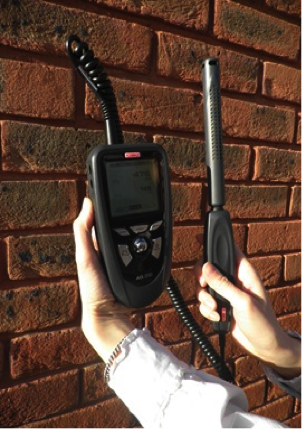Vane Probe Anemometer
 An effective and efficient ventilation strategy is vital to improve energy efficiency and create a healthy workplace environment. Inadequate ventilation can cause high levels of CO2 exhaled from occupants, leading to an unsafe and unhealthy working environment. In contrast, over-ventilation results in heating waste, excessive fan operation and thermal discomfort due to breeze.
An effective and efficient ventilation strategy is vital to improve energy efficiency and create a healthy workplace environment. Inadequate ventilation can cause high levels of CO2 exhaled from occupants, leading to an unsafe and unhealthy working environment. In contrast, over-ventilation results in heating waste, excessive fan operation and thermal discomfort due to breeze.
The Sustainable Building Futures’ air quality testing equipment can be used to provide a spot check of CO2/CO concentration levels within a space in order to optimise ventilation performance and ensure a healthy working environment.
Our indoor air quality equipment, with backlit digital display, comprises:
- a CO2 probe, which can be used for both outdoor and indoor readings, within the measuring range between 0 and 5000 parts per million (ppm);
- a CO probe, which can be used for both outdoor and indoor readings, within the measuring range between 0 and 500 ppm.
Both probes also measure temperature within the range of -20 to 80 degrees Celsius.
The presence of CO2 in the atmosphere is typically around 350 parts per million (ppm) and the Occupational Safety and Health Administration (OSHA) has set a permissible exposure limit (PEL) for CO2 of 5,000ppm over an 8-hour work day. The maximum recommended indoor CO2 concentration is 1000 ppm (provided at a ventilation rate of 7 l/s per person) as in ASHRAE Standards.
The natural presence of CO in the atmosphere is 0.2ppm. CO concentration levels are critical due to its effect of reducing the ability of transporting oxygen by blood. CO is found in combustion fumes, such as burning charcoal, burning wood, or gas ranges and heating systems. The PEL set by the Health and Safety Executive in the UK for CO is 50ppm.





